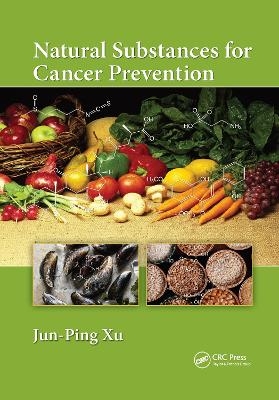
Natural Substances for Cancer Prevention
CRC Press (Verlag)
978-1-032-33924-5 (ISBN)
Accordingly, important goals for cancer prevention are the modification of our dietary habits and an increase in the intake of more anticancer-related natural substances. More significantly, the bioactive chemicals presented in the functional foods should be readily available, inexpensive, non-toxic, and nutritional.
Jun-Ping Xu earned a PhD in pharmaceutical sciences and medicinal chemistry at the Tokyo University of Pharmacy and Life Sciences in Japan in 1988. He has worked at the Shanghai Institute of Pharmaceutical Industry and the Shanghai Institute of Materia Medica, Chinese Academy of Sciences. Dr. Xu currently works at the Cancer Research Institute and School of Molecular Sciences at Arizona State University, USA, as a research professor.
Preface
Author
Introduction
Chapter 1 Cancer-Preventive Substances in Green Vegetables
1. Amaranth
2. Asparagus
3. Brassicaceae Vegetables
4. Celery
5. Chive
6. Chinese Garlic and Scallion
7. Leek
8. Spinach
Chapter 2 Cancer-Preventive Substances in Fruit and Flower Vegetables
9. Artichoke
10. Bitter Gourd/Bitter Melon
11. Cochinchin Gourd/Gac Fruit
12. Eggplant
13. Myoga Ginger
14. Okra
15. Pumpkin
16. Tomato
Chapter 3 Cancer-Preventive Substances in Root Vegetables
17. Carrot
18. Garlic
19. Onion
20. Konjac/Moyu
21. Potato
22. Red Beet or Chard
23. Sweet Potato
Chapter 4 Cancer-Preventive Substances in Grains and Beans
24. Adlay, Coixseed, or Job’s Tears
25. Barley
26. Buckwheat
27. Common Beans
28. Corn
29. Foxtail Millet
30. Mung Bean
31. Oat
32. Soybean
Chapter 5 Cancer-Preventive Substances in Fruits
33. Avocado
34. Cherry
35. Chestnut Rose
36. Citrus Fruits
37. Cranberry
38. Fig Fruit
39. Grape
40. Guava
41. Hawthorn Berry
42. Jujube
43. Kiwi Fruit
44. Mango
45. Papaya
46. Persimmon
47. Pomegranate
48. Ume, Chinese Plum, or Japanese Apricot
Chapter 6 Cancer-Preventive Substances in Flavorings
49. Chili Pepper
50. Chinese Pepper
51. Lemongrass
52. Fennel
53. Ginger
54. Rosemary
55. Star Anise
56. Thyme
Chapter 7 Cancer-Preventive Substances in Beverages
57. Coffee
58. Tea
Chapter 8 Cancer-Preventive Substances in Mushrooms
59. Bamboo Fungus or Veiled Lady Mushroom
60. Golden Oyster Mushroom
61. Jew’s Ear, Jelly Ear, or Judas’s Ear
62. Lion’s Mane Mushroom
63. Maitake or Signorina Mushroom and Chestnut Mushroom
64. Mongolia Tricholoma
65. Oyster Mushroom
66. Pine Mushroom
67. Princess Matsutake or Brazilian Mushroom
68. Ringless Honey Mushroom
69. Shiitake or Sawtooth Oak Mushroom
70. Snow Fungus
71. Split Gill Mushroom
72. Straw Mushroom
73. Winter Mushroom or Enokitake
Chapter 9 Cancer-Preventive Substances in Seaweeds
74. Alga Gloiopeltidis
75. Chipolata Weed
76. Dried Moss of Enteromorphites or Hutai
77. Hijiki
78. Kelp
79. Kurome
80. Laver or Nori
81. Sea Mustard
82. Umitoranoo
Chapter 10 Cancer-Preventive Substances in Microalgae
83. Chlorella
84. Spherical Nostoc
85. Spirulina
Chapter 11 Cancer-Preventive Substances in Animal-Based Foods
86. Fresh-Water Mussels
87. Marine Mussels
88. Hard Clam
89. Other Clams
90. Sepia Ink
91. Calamari Ink
92. Sea Cucumber
93. Lollyfish Sea Cucumber
Index of Latin Names for Functional Comestibles
Index of English Names for Functional Comestibles
Index of Acronyms
| Erscheinungsdatum | 14.06.2022 |
|---|---|
| Zusatzinfo | 72 Illustrations, black and white |
| Verlagsort | London |
| Sprache | englisch |
| Maße | 178 x 254 mm |
| Gewicht | 889 g |
| Themenwelt | Sachbuch/Ratgeber ► Gesundheit / Leben / Psychologie |
| Studium ► Querschnittsbereiche ► Prävention / Gesundheitsförderung | |
| Naturwissenschaften ► Biologie ► Biochemie | |
| Technik ► Lebensmitteltechnologie | |
| ISBN-10 | 1-032-33924-1 / 1032339241 |
| ISBN-13 | 978-1-032-33924-5 / 9781032339245 |
| Zustand | Neuware |
| Informationen gemäß Produktsicherheitsverordnung (GPSR) | |
| Haben Sie eine Frage zum Produkt? |
aus dem Bereich


